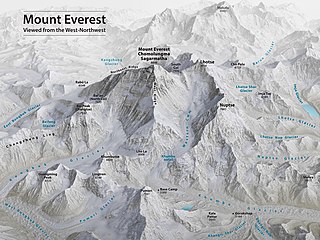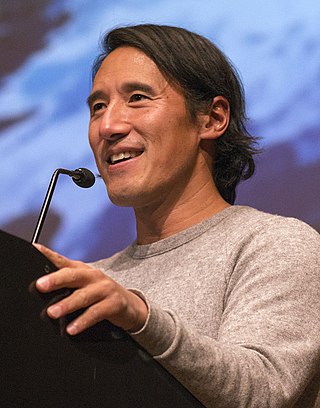Related Research Articles

Kangchenjunga, also spelled Kanchenjunga, Kanchanjanghā and Khangchendzonga, is the third-highest mountain in the world. Its summit lies at 8,586 m (28,169 ft) in a section of the Himalayas, the Kangchenjunga Himal, which is bounded in the west by the Tamur River, in the north by the Lhonak River and Jongsang La, and in the east by the Teesta River. It lies in the border region between Koshi Province of Nepal and Sikkim state of India, with the two peaks West and Kangbachen in Nepal's Taplejung District and the other three peaks Main, Central and South directly on the border.

Mount Everest(also Mount Sagarmatha or Mount Qomolangma) is Earth's highest mountain above sea level, located in the Mahalangur Himal sub-range of the Himalayas. The China–Nepal border runs across its summit point. Its elevation of 8,848.86 m was most recently established in 2020 by the Chinese and Nepali authorities.

Lhotse is the fourth-highest mountain on Earth, after Mount Everest, K2, and Kangchenjunga. At an elevation of 8,516 metres (27,940 ft) above sea level, the main summit is on the border between Tibet Autonomous Region of China and the Khumbu region of Nepal.

Makalu is the fifth-highest mountain on Earth, with a summit at an elevation of 8,485 metres (27,838 ft) AMSL. It is located in the Mahalangur Himalayas 19 km (12 mi) southeast of Mount Everest, on the China–Nepal border. One of the eight-thousanders, Makalu is an isolated peak shaped as a four-sided pyramid.

Cho Oyu is the sixth-highest mountain in the world at 8,188 metres (26,864 ft) above sea level. Cho Oyu means "Turquoise Goddess" in Tibetan. The mountain is the westernmost major peak of the Khumbu sub-section of the Mahalangur Himalaya 20 km west of Mount Everest. The mountain stands on the China–Nepal border, between the Tibet Autonomous Region and Koshi Province.

Dhaulagiri, located in Nepal, is the seventh highest mountain in the world at 8,167 metres (26,795 ft) above sea level, and the highest mountain within the borders of a single country. It was first climbed on 13 May 1960 by a Swiss-Austrian-Nepali expedition. Annapurna I is 34 km (21 mi) east of Dhaulagiri. The Kali Gandaki River flows between the two in the Kaligandaki Gorge, said to be the world's deepest. The town of Pokhara is south of the Annapurnas, an important regional center and the gateway for climbers and trekkers visiting both ranges as well as a tourist destination in its own right.

Manaslu is the eighth-highest mountain in the world at 8,163 metres (26,781 ft) above sea level. It is in the Mansiri Himal, part of the Nepalese Himalayas, in west-central Nepal. Manaslu means "mountain of the spirit" and the word is derived from the Sanskrit word manasa, meaning "intellect" or "soul". Manaslu was first climbed on May 9, 1956, by Toshio Imanishi and Gyalzen Norbu, members of a Japanese expedition. It is said that, given the many unsuccessful attempts by the British to climb Everest before Nepali Tenzing Norgay and New Zealander Edmund Hillary, "just as the British consider Everest their mountain, Manaslu has always been a Japanese mountain".

Shishapangma, or Shishasbangma or Xixiabangma, is the 14th-highest mountain in the world, at 8,027 metres (26,335 ft) above sea level. It is located entirely within Tibet. In 1964, it became the final eight-thousander to be climbed.

Pumori is a mountain on the Nepal-China border in the Mahalangur section of the Himalayas. Pumori lies just eight kilometres west of Mount Everest. Pumori, meaning "the Mountain Daughter" in Sherpa language, was named by George Mallory. "Pumo" means young girl or daughter and "Ri" means mountain in Sherpa language. Climbers sometimes refer to Pumori as "Everest's Daughter". Mallory also called it Clare Peak, after his daughter.

Anatoli Nikolaevich Boukreev was a Soviet and Kazakh mountaineer who made ascents of 10 of the 14 eight-thousander peaks—those above 8,000 m (26,247 ft)—without supplemental oxygen. From 1989 through 1997, he made 18 successful ascents of peaks above 8,000 m.

Jean-Christophe Lafaille was a French climber noted for a number of difficult ascents in the Alps and Himalaya, and for what has been described as "perhaps the finest self-rescue ever performed in the Himalaya", when he was forced to descend the mile-high south face of Annapurna alone with a broken arm, after his climbing partner had been killed in a fall. He climbed eleven of the fourteen eight-thousanders, many of them alone or by previously unclimbed routes, but disappeared during a solo attempt to make the first winter ascent of Makalu, the world's fifth highest mountain.

Mount Everest is the world's highest mountain, with a peak at 8,849 metres (29,031.7 ft) above sea level. It is situated in the Himalayan range of Solukhumbu district, Nepal.

Conrad Anker is an American rock climber, mountaineer, and author. He was the team leader of The North Face climbing team for 26 years until 2018. In 1999, he located George Mallory's body on Everest as a member of a search team looking for the remains of the British climber who was last seen in 1924. Anker had a heart attack in 2016 during an attempted ascent of Lunag Ri with David Lama. He was flown via helicopter to Kathmandu where he underwent emergency coronary angioplasty with a stent placed in his proximal left anterior descending artery. Afterwards he retired from high altitude mountaineering, but otherwise he continues his work. He lives in Bozeman, Montana.

Jimmy Chin is an American professional mountain athlete, photographer, skier, film director, and author.
Victor Saunders is a British climber, mountain guide and author. He has summitted Mount Everest six times, and has climbed all the Seven Summits. His first book, Elusive Summits, won the Boardman Tasker Prize for Mountain Literature in 1991.

The 1975 British Mount Everest Southwest Face expedition was the first to successfully climb Mount Everest by ascending one of its faces. In the post-monsoon season Chris Bonington led the expedition that used rock climbing techniques to put fixed ropes up the face from the Western Cwm to just below the South Summit. A key aspect of the success of the climb was the scaling of the cliffs of the Rock Band at about 8,200 metres (27,000 ft) by Nick Estcourt and Tut Braithwaite.
Precipitated by unexpected permission from Tibet, the 1935 British Mount Everest reconnaissance expedition was planned at short notice as a preliminary to an attempt on the summit of Mount Everest in 1936. After exceptionally rancorous arguments involving the Mount Everest Committee in London, Eric Shipton was appointed leader following his successful trekking expedition to the Nanda Devi region in India in 1934.
The 1951 British Mount Everest reconnaissance expedition ran between 27 August 1951 and 21 November 1951 with Eric Shipton as leader.
References
- ↑ According to the Tribune India article